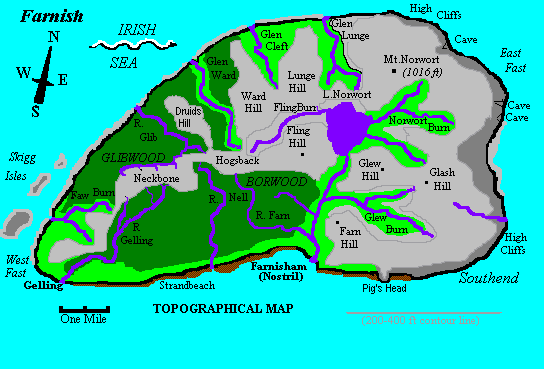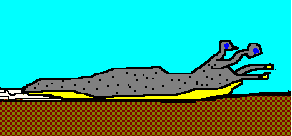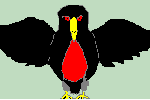From the Library of Porpentinus CripplewortSome NOTES ~on theGeography, Peoples, &HISTORY(Natural and Humane)of theStrange & WonderfulISLANDofFARNISH,Compiled and Indexed by Porpentinus Cripplewort, Esq., of Farnish Castle, Isle of Farnish, from his own Various and Sundry Researches.Written in theYear of Our LordMDCCCXLI* * ** *Facsimile of the Original MS, made by Grobius Shortling, 5th in direct descent (via a byblow) from the Author, with revisions, and abridgements, in the year 1967... Porpentinus Cripplewort (1653?-1842) lived through a period of time that was not to be equalled for extraordinary changes until the Wright Brothers transformed kites into spaceships.
TRANSCRIBER'S NOTE: The Original
Manuscript runs to over 1000 pages (foolscap). The following booklet
is a drastic abridgement designed only to convey to the interested
reader some of the charm and erudition of the original author. Should
public interest be hereby stimulated, I will in the future issue the
work in its entirety.
[A note on the illustrations. Lacking the proper equipment, I was unable to reproduce the original Cripplewort drawings and have re-created some of them using 'Paintbrush'. Audubon it's not. My apologies. --G.S.]
| |
|
|
The Heraldic Beast of Farnish, portrayed on the Arms, Banners, Ensigns, etc. of the island. |
The Thorn-Billed Egret (Ardea spicus)
An extremely rare migratory bird, nesting in Spring on the East and West Fasts. The hen lays only one egg per season, regardless of whether it is fertile or not. It has been reported, without verification, that these creatures Winter in the Land of Serendip.
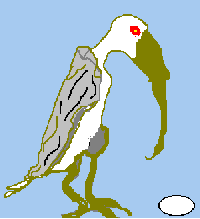
[I was kind of smashed when I 'Paintbrushed' this, but surprisingly the effect came out just the way I wanted it! The beak should have been more orangey than greenish. --G.S.]
The Himp Rat (Mus Limpus)
The common Rat of Farnish. Characterised by a long red tail and curled yellow tusks, the Himp Rat is a carrier of Himp Fever, formerly called the Green Sweats, a disease, often fatal, in which the victim literally turns mouldy. The 5th Lord Farnisham (d. 1627) perished from this malady, as did seven of his eight children. Hugh Greenface, the Baker, is the only man known to suffer the disease chronically, as one is usually carried off quickly or recovers suddenly with a shedding of all skin, which henceforth takes on the characteristic Farnish 'blue hue'.
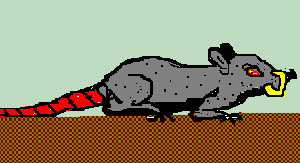
The Tree Pigs (Swinus arboris [Porcus])
Domiciled in GLIB WOOD. Little is known of this arboreal creature as no one (save for the Treepigg Family, traditional hunters of the beast) has ever seen one in its habitat. But I can report that they are delicious to eat.
The Farnishite Barque
An unusual mode of marine transport:
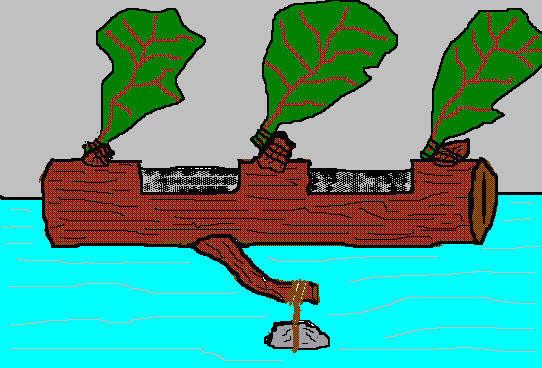
This strange vehicle is still in use by a few fishermen of the village of Gelling. The Farnishite Barque is actually a hollowed Beech Tree Trunk (traditionally, this is the only wood used). One long branch is left on the trunk as a Keel, from which a large stone is hung as ballast. Three shorter stumps are left topside to which there are attached freshly cut leafy boughs to serve as a means of propulsion by wind. The barque shown above seats two persons. The largest known boat of this kind was said to have seated fifteen.
The Farnishite Casting Thiln
This hunting weapon, the expert use of which is early inculcated among the Young of the Island, has been utilised since pre-history. It consists of a foot-long straight Ash stick and a half dozen large flat stones pierced by a hole and fitting loosely on the stick. The stones are carried on a specially hooked belt called a Hab. The missiles are called Runes, from the Runic characters carved on each to denote ownership. By fitting a Rune on to the stick (or Thiln), one can, by flicking the latter in the direction of the target, direct the Rune with considerable force and accuracy at a running or stationary mark. This is called Casting the Runes.
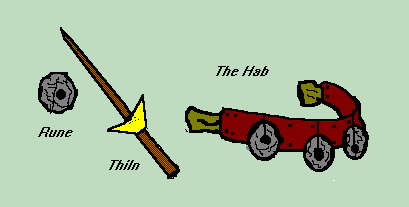
A Strange Custom
HUMBUG DANCING
On Midsummer's Day it is customary to find the Islanders gathered in the Market Places of Gelling and Farnisham for what is called the "Humbug Fest." Aside from the usual festive activities (much drinking of Beer and the local brew Shlug), the most notable event of the day is the Humbug Dance, which starts at sunrise and continues by relay until sunset, at which time the best dancer is judged King of the Humbugs by popular acclaim. The dance is performed with one's hands, while the dancer is suspended from a tree by ropes.
[A kind of Bungee Hand Jive? Among the uncompiled notes to the original book, there was a mention that the winner was often thrown promptly into the harbor. --G.S.]
The Literature of Farnish
There has been but one poet of note in the history of Farnish. This was Billy 'Maister' Millweel (1750-1848*), who wrote his first poem at the age of 82, after his retirement from the Fish-Scaling factory. He produced 8 volumes of poetry...celebrating the History of the Island -- his best in this vein being the Epic "Nellie the Bold" --, its topography, and its industries. He also collected the 22 extant anonymous ballads and songs of Farnish, dating from c.1500 to the present.... Farnish has produced no writers of prose or fiction to date [1841]**
* Date of death supplied by the editor. There is a posthumous poem
by the author that records this event.
** The astute observer will have observed a Shortling Isomerism in
this. --G.S.
The People of Farnish and Their History
[There are some hot spots on the map that link to other references or just pop up text boxes.]
KEY TO SITE MAP | |
| Places of Interest | Regional Summaries |
|
1. Gelling Castle 2. Glib Castle ruins & hamlet 3. Tower ruins in Glib Gap 4. Borwood Hunting Lodge 5. The Mill 6. Loch Norwort Hotel 7. Farnisham Castle 8. Glew Farm 9. Watch Tower 10. Farn Manor estate 11. Glen Lunge Summer Lodge 12. Crudburn Tower 13. Salisbaker Tower 14. Pig's Head |
NORTHERN FELLS: mainly sheep raising (small farmsteads are located at the seaward ends of three glens). WEST FAST: Gelling fishing village (landing to the north used when bad southern gales isolate Gelling harbor). SKIGG ISLES: Uninhabited except for sea birds; occasional Eremites. GLIBWOOD & BORWOOD: Mostly Holm Oak forest; separated by the Neckbone and Hogsback ridges, crossover at Glib Gap. C. Farn Common ('The Boggs') D. Dam & Causeway (enlarges the lake) EAST FAST: High cliffs along all the east coast; no reliable landing places. (Some nice caves, but be careful) N. Nell Falls beauty spot (overrun by midges in the summer) *. Fling Point Overlook (fine views) LAKE NORWORT: Mountain lake (artificially deepened in places); the Hotel is a failed Victorian spa, but is still open (One has to love stodgy places to enjoy it). SOUTHEND: Reasonably farmable Downs-like country; Glew Farm is the main farm of the island (belongs to the Manor, but in fact is ruled by Mrs Mabel Mitherglew). |
| [Note: There is always a Mrs Mitherglew in a major position of control in Farnish; the current Mrs M runs the Post Office, Tea Shop & General Store on the Market Square. -- G.S.] | |
[Well, here we go again.]
[This is a very large section even in my abridged edition. I do not have the time or energy to input all this into the computer at this point in time. Sorry. --G.S.]
A note for the curious: Tigti Yellowbeard is reputed to have spent a period of exile here in the 1050's (see Marshmount Castle).
{Maybe some day I'll put in the rest of this... G.S.}
Home Page
Appendix
[The abridged version of Porpentinus Cripplewort's monograph was done in 1967. While updating this for the Internet in 1996, I noticed a glaring omission, which is hereby remedied. --G.S.]
FARNISH PUB GUIDE (also Restaurants, Cafes, B&B's, etc.)
Should you ever come to visit Farnish (which is not that likely, as it is a very hard place to find, let alone get to), you might like to know the following -- in fact, to survive, you HAVE to know.... Although the island only has about 1600 inhabitants, there are plenty of pubs. Places to stay, and other amenities (such as public Loos), are very rare. In spite of its decrepit condition, the LOCH NORWORT HOTEL is your best bet for a visit to be remembered and cherished, and it is centrally located (not conveniently, since there is no public transport -- yet they do provide a mule-cart service when you can stir up the groom).
 Go right to Pub Guide
Go right to Pub Guide